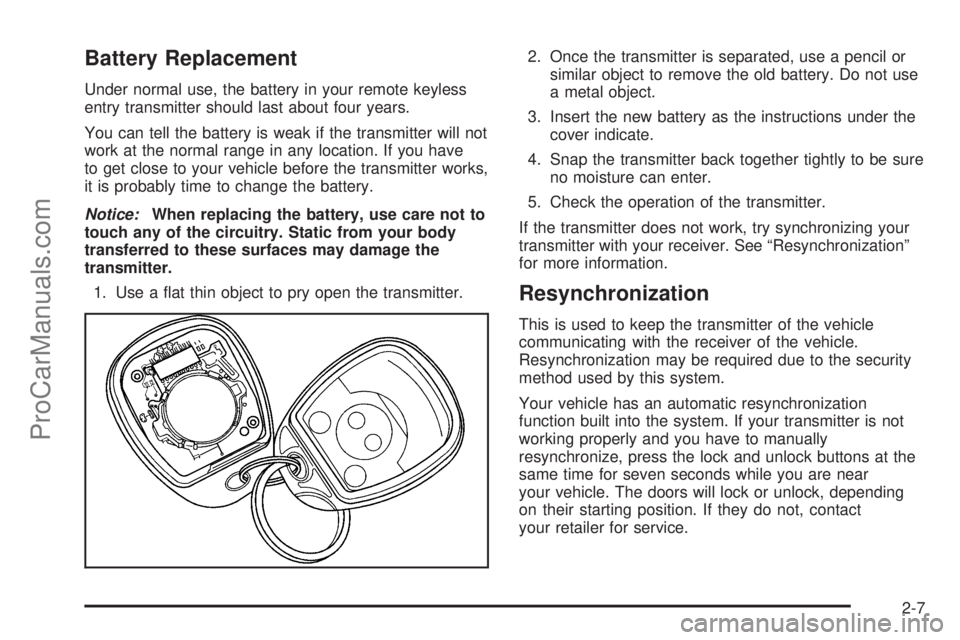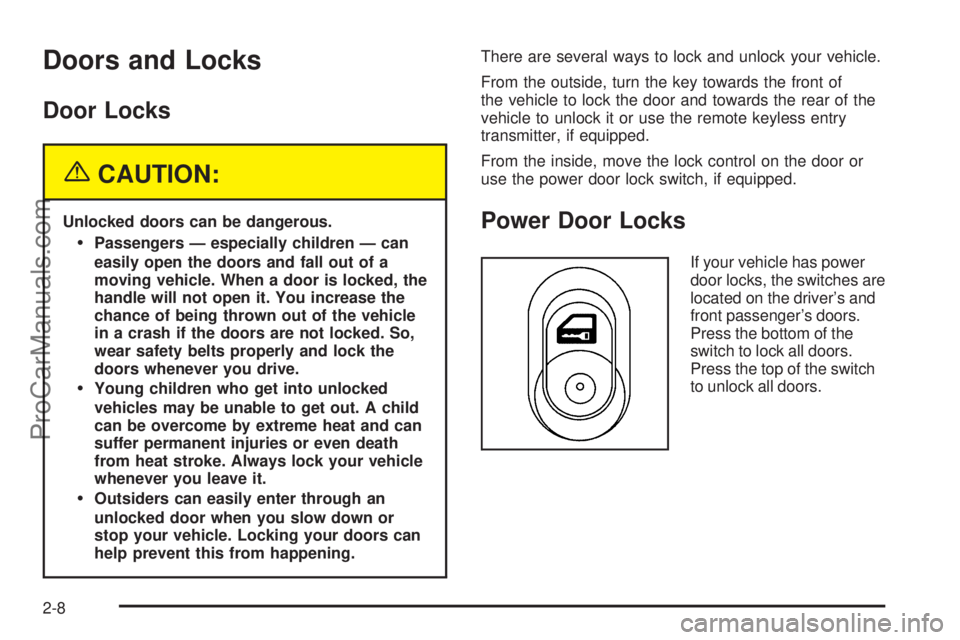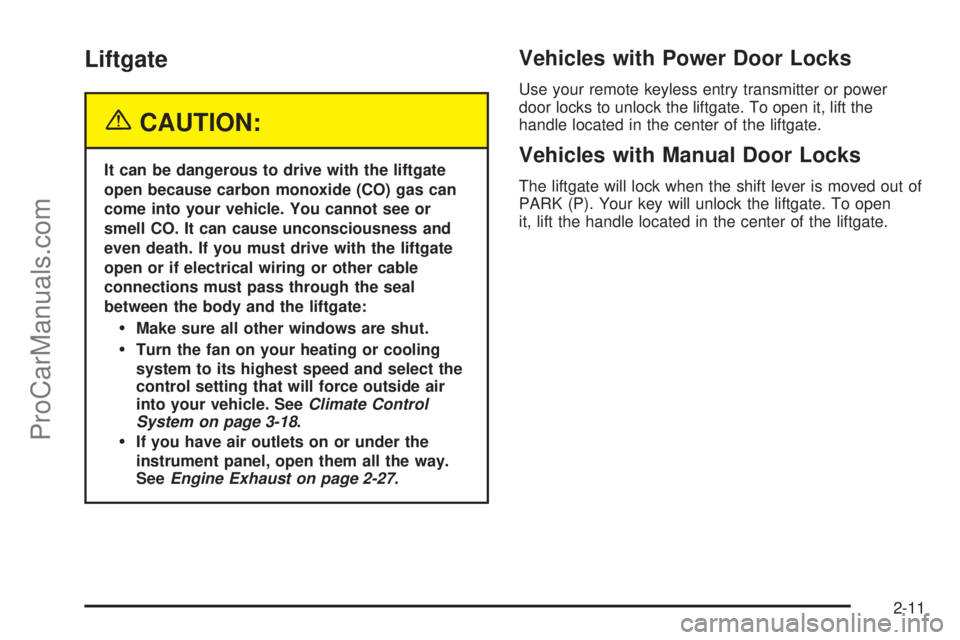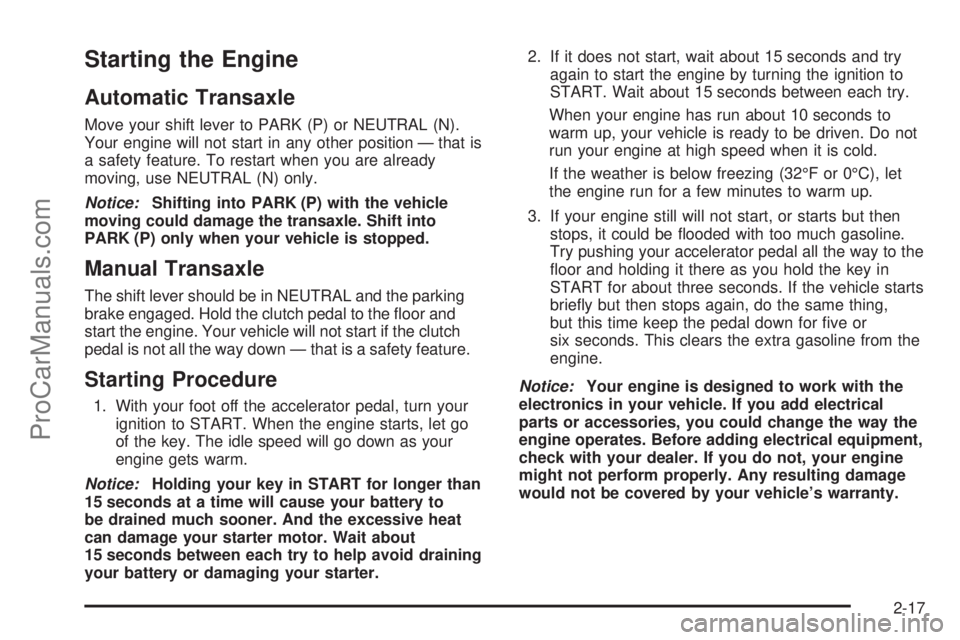key SATURN VUE 2005 User Guide
[x] Cancel search | Manufacturer: SATURN, Model Year: 2005, Model line: VUE, Model: SATURN VUE 2005Pages: 384, PDF Size: 2.8 MB
Page 73 of 384

Battery Replacement
Under normal use, the battery in your remote keyless
entry transmitter should last about four years.
You can tell the battery is weak if the transmitter will not
work at the normal range in any location. If you have
to get close to your vehicle before the transmitter works,
it is probably time to change the battery.
Notice:When replacing the battery, use care not to
touch any of the circuitry. Static from your body
transferred to these surfaces may damage the
transmitter.
1. Use a �at thin object to pry open the transmitter.2. Once the transmitter is separated, use a pencil or
similar object to remove the old battery. Do not use
a metal object.
3. Insert the new battery as the instructions under the
cover indicate.
4. Snap the transmitter back together tightly to be sure
no moisture can enter.
5. Check the operation of the transmitter.
If the transmitter does not work, try synchronizing your
transmitter with your receiver. See “Resynchronization”
for more information.
Resynchronization
This is used to keep the transmitter of the vehicle
communicating with the receiver of the vehicle.
Resynchronization may be required due to the security
method used by this system.
Your vehicle has an automatic resynchronization
function built into the system. If your transmitter is not
working properly and you have to manually
resynchronize, press the lock and unlock buttons at the
same time for seven seconds while you are near
your vehicle. The doors will lock or unlock, depending
on their starting position. If they do not, contact
your retailer for service.
2-7
ProCarManuals.com
Page 74 of 384

Doors and Locks
Door Locks
{CAUTION:
Unlocked doors can be dangerous.
Passengers — especially children — can
easily open the doors and fall out of a
moving vehicle. When a door is locked, the
handle will not open it. You increase the
chance of being thrown out of the vehicle
in a crash if the doors are not locked. So,
wear safety belts properly and lock the
doors whenever you drive.
Young children who get into unlocked
vehicles may be unable to get out. A child
can be overcome by extreme heat and can
suffer permanent injuries or even death
from heat stroke. Always lock your vehicle
whenever you leave it.
Outsiders can easily enter through an
unlocked door when you slow down or
stop your vehicle. Locking your doors can
help prevent this from happening.There are several ways to lock and unlock your vehicle.
From the outside, turn the key towards the front of
the vehicle to lock the door and towards the rear of the
vehicle to unlock it or use the remote keyless entry
transmitter, if equipped.
From the inside, move the lock control on the door or
use the power door lock switch, if equipped.
Power Door Locks
If your vehicle has power
door locks, the switches are
located on the driver’s and
front passenger’s doors.
Press the bottom of the
switch to lock all doors.
Press the top of the switch
to unlock all doors.
2-8
ProCarManuals.com
Page 75 of 384

Delayed Locking
A chime will sound three times to indicate a door or
liftgate is open when you try to lock the doors with the
remote keyless entry transmitter or the power door
lock switch. The doors will not lock, and the
theft-deterrent system will not arm until all the doors are
closed and �ve seconds have passed.
The delayed locking feature can be overridden by
pressing the lock button on the remote keyless entry
transmitter, or the door lock switch, a second time. The
doors will lock immediately and when all doors are
closed the theft-deterrent system will arm after
30 seconds.
To get the horn to chirp if a door was open during the
arming process, you must press the lock button on your
transmitter twice after the doors are closed.
Programmable Automatic
Door Locks
For a vehicle with an automatic transaxle, all the doors
will lock when the ignition is in RUN and the shift
lever is moved out of PARK (P). For a vehicle with a
manual transaxle, all the doors will lock when the vehicle
reaches a speed of more than 3 mph (5 km/h). All
doors must be closed.
In the following situations, all doors will lock
again when:
The brake pedal is applied, a door is opened and
then closed, and the brake pedal is released, for
a vehicle with an automatic transaxle.
A door is opened and then closed while the vehicle
is moving faster than 3 mph (5 km/h), for a vehicle
with an manual transaxle.
For a vehicle with an automatic transaxle, all doors will
unlock when the shift lever is moved into PARK (P).
For a vehicle with a manual transaxle, all doors
will unlock when the key is removed from the ignition.
The unlocking feature can be programmed on or
off by turning the ignition to RUN, engine not running,
and pressing the unlock part of the power door lock
switch for eight seconds. The horn will chirp once when
this feature is on and will chirp twice when it is off.
2-9
ProCarManuals.com
Page 76 of 384

Rear Door Security Locks
Your vehicle has rear door security locks that prevent
passengers from opening the rear doors from the inside.
The rear door security
locks are located on the
inside edge of each
rear door.
To set the rear door security locks, do the following:
1. Insert the key into the lock above the rear door
security lock label and turn it clockwise for the
driver’s side and counterclockwise for the
passenger’s side.
2. Close the door.When you want to open a rear door when the security
lock is on, do the following:
1. Unlock the door using the remote keyless entry
transmitter, the power door lock switch, or by
lifting the rear door manual lock.
2. Open the door from the outside.
To cancel the rear door security lock, do the following:
1. Unlock the door and open it from the outside.
2. Insert the key into the slot next to the rear door
security lock label and turn it counterclockwise for
the driver’s side and clockwise for the
passenger’s side.
Lockout Protection
If you press the power door lock switch when the key is
in the ignition and any door is open, all the doors will
lock and then the driver’s door will unlock. Be sure
to remove the key from the ignition when locking your
vehicle.
If the keyless entry transmitter is used to lock the doors
and the key is in the ignition, a chime will sound
three times. All doors will lock.
2-10
ProCarManuals.com
Page 77 of 384

Liftgate
{CAUTION:
It can be dangerous to drive with the liftgate
open because carbon monoxide (CO) gas can
come into your vehicle. You cannot see or
smell CO. It can cause unconsciousness and
even death. If you must drive with the liftgate
open or if electrical wiring or other cable
connections must pass through the seal
between the body and the liftgate:
Make sure all other windows are shut.
Turn the fan on your heating or cooling
system to its highest speed and select the
control setting that will force outside air
into your vehicle. SeeClimate Control
System on page 3-18.
If you have air outlets on or under the
instrument panel, open them all the way.
SeeEngine Exhaust on page 2-27.
Vehicles with Power Door Locks
Use your remote keyless entry transmitter or power
door locks to unlock the liftgate. To open it, lift the
handle located in the center of the liftgate.
Vehicles with Manual Door Locks
The liftgate will lock when the shift lever is moved out of
PARK (P). Your key will unlock the liftgate. To open
it, lift the handle located in the center of the liftgate.
2-11
ProCarManuals.com
Page 79 of 384

Power Windows
If your vehicle has this
feature the switches are
located on each side of the
shift lever on the console.
To open a window press the switch down and lift up to
close it.
The power windows can operate only when the ignition
key is in RUN or ACC.
A rear window switch is located on each rear door.
Press the bottom half of the switch to open the window
and the top to close it.
Express-Down Window
The driver’s window switch has an express-down
feature that is labeled AUTO. Press the switch all the
way down and hold it there momentarily, and the driver’s
window will go all the way down. To stop the automatic
function, lift the switch all the way up and release it.
Window Lock Out
The driver’s window controls also include a lock-out
switch. Press the window lock switch to the left to stop
rear passengers from using their window switches.
The driver can still control all the windows with the lock
on. Press the right side of the window lock button to
return to normal window operation.
Sun Visors
To block out glare swing the visors down or to the side.
Visor Vanity Mirrors
Your vehicle has covered visor vanity mirrors.
2-13
ProCarManuals.com
Page 80 of 384

Theft-Deterrent Systems
Vehicle theft is big business, especially in some cities.
Although your vehicle has a number of theft-deterrent
features, we know that nothing we put on it can make it
impossible to steal.
Passlock®
Your vehicle is equipped with the Passlock®
theft-deterrent system.
This light will come on for
the theft-deterent system.
Passlock
®is a passive theft-deterrent system.
Passlock®enables fuel if the ignition lock cylinder is
turned with a valid key. If a correct key is not used or the
ignition lock cylinder is tampered with, fuel is disabled.During normal operation, the security light will go off
approximately �ve seconds after the key is turned
to RUN following an engine start.
If the engine stalls and the security light �ashes, wait
until the light stops �ashing before trying to restart
the engine. Remember to release the key from START
as soon as the engine starts.
If the engine is running and the security light comes on,
you will be able to restart the engine if you turn the
engine off. However, your Passlock
®system is
not working properly and must be serviced by your
retailer. Your vehicle is not protected by Passlock
®at
this time. You may also want to check the fuses,
seeFuses and Circuit Breakers on page 5-93. See your
retailer for service. Also, seeRoadside Assistance
Program on page 7-5for more information.
2-14
ProCarManuals.com
Page 81 of 384

Starting and Operating Your
Vehicle
New Vehicle Break-In
Notice:Your vehicle does not need an elaborate
break-in. But it will perform better in the long run if
you follow these guidelines:
Do not drive at any one speed, fast or slow, for
the �rst 500 miles (805 km). Do not make
full-throttle starts.
Avoid making hard stops for the �rst 200 miles
(322 km) or so. During this time your new
brake linings are not yet broken in. Hard stops
with new linings can mean premature wear
and earlier replacement. Follow this breaking-in
guideline every time you get new brake
linings.
Do not tow a trailer during break-in. SeeTowing
a Trailer on page 4-55for more information.
Ignition Positions
With the key in the ignition switch, you can turn it to four
different positions.
LOCK
q:This position locks your steering column in a
vehicle with a manual transaxle. It is a theft-deterrent
feature. You will only be able to remove your key when
the ignition is turned to LOCK.
2-15
ProCarManuals.com
Page 82 of 384

If you have an automatic transaxle, the ignition switch
cannot be turned to LOCK unless the shift lever is
in PARK (P).
Notice:Using a tool to force the key from the
ignition switch could cause damage or break the
key. Use the correct key and turn the key only with
your hand. Make sure the key is all the way in. If
it is, turn the steering wheel left and right while you
turn the key hard. If none of this works, then
your vehicle needs service.
{CAUTION:
If you have a manual transaxle removing the
key from the ignition switch will lock the
steering column and result in a loss of ability
to steer the vehicle. This could cause a
collision. If you need to turn the engine off
while the vehicle is moving, turn the key
to ACC.ACC (Accessory):This position operates some of your
electrical accessories. It unlocks the steering wheel
and ignition.
RUN:This is the position the switch returns to after you
start your engine and release the switch. The switch
stays in RUN when the engine is running. But even
when the ignition is not running, you can use RUN to
operate your electrical accessories and to display some
warning and indicator lights.
rSTART:This position starts the engine. When the
engine starts, release the key. The ignition switch
will return to RUN for normal driving.
A warning tone will sound if you open the driver’s door
when the key has not been removed from the ignition.
2-16
ProCarManuals.com
Page 83 of 384

Starting the Engine
Automatic Transaxle
Move your shift lever to PARK (P) or NEUTRAL (N).
Your engine will not start in any other position — that is
a safety feature. To restart when you are already
moving, use NEUTRAL (N) only.
Notice:Shifting into PARK (P) with the vehicle
moving could damage the transaxle. Shift into
PARK (P) only when your vehicle is stopped.
Manual Transaxle
The shift lever should be in NEUTRAL and the parking
brake engaged. Hold the clutch pedal to the �oor and
start the engine. Your vehicle will not start if the clutch
pedal is not all the way down — that is a safety feature.
Starting Procedure
1. With your foot off the accelerator pedal, turn your
ignition to START. When the engine starts, let go
of the key. The idle speed will go down as your
engine gets warm.
Notice:Holding your key in START for longer than
15 seconds at a time will cause your battery to
be drained much sooner. And the excessive heat
can damage your starter motor. Wait about
15 seconds between each try to help avoid draining
your battery or damaging your starter.2. If it does not start, wait about 15 seconds and try
again to start the engine by turning the ignition to
START. Wait about 15 seconds between each try.
When your engine has run about 10 seconds to
warm up, your vehicle is ready to be driven. Do not
run your engine at high speed when it is cold.
If the weather is below freezing (32°F or 0°C), let
the engine run for a few minutes to warm up.
3. If your engine still will not start, or starts but then
stops, it could be �ooded with too much gasoline.
Try pushing your accelerator pedal all the way to the
�oor and holding it there as you hold the key in
START for about three seconds. If the vehicle starts
brie�y but then stops again, do the same thing,
but this time keep the pedal down for �ve or
six seconds. This clears the extra gasoline from the
engine.
Notice:Your engine is designed to work with the
electronics in your vehicle. If you add electrical
parts or accessories, you could change the way the
engine operates. Before adding electrical equipment,
check with your dealer. If you do not, your engine
might not perform properly. Any resulting damage
would not be covered by your vehicle’s warranty.
2-17
ProCarManuals.com